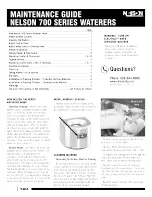
DOOR PANEL INSTALLATION
escription of the configuration dip switch of the
D
sound module EL520.
The SW1 configuration dip switch is located at the rear side
of the sound module.
Set the switch to ON for telephones programming.
Once the programming is finished, return the switch to OFF position.
The programming method is described in page 67.
62
Set the switch to OFF if it is the main door panel. Every system must have
only a main door panel; the rest must be slave door panels (ON). Set
as the main door panel the most remote from the backbone. If in the
system it has installed a digital converter CD-2PLUS, the max. number
of door panels will be of 2 and they must be configured as slave.
Set the switch to ON in case of call forwarding from the door panel to
the porter’s exchange (when it is activated). Set the switch to OFF if
this function is not required (it needs a CD-2PLUS converter and that
door panel capture is activated in the porter’s exchange).
Set the switch to ON so that the tones emited by the door panel are
HIGH or set it OFF if the volume should be LOW.
escription of the self-testing leds.
D
The self-testing leds are placed together with the SW1
configuration dip switch.
Green
Red
Red led
Fixed: More than one door panel set as master.
In case of short/circuit, if it is removed
before 2 minutes (approx.), the door
panel will automatically reset; in case
of more than 2 minutes, it is necessary
to switch it off and then switch it on
again.
Green led
Fixed: Correct operation.
Blinking: Programming in progress of the door panel
(2nd configuration dip switch in ON).
Blinking: There is a crossover in the installation*
between bus wires or there isn’t any door
panel configured as master.
*
*Factory default
ush buttons limit.
P
ush buttons code.
P
DOOR PANEL INSTALLATION
The maximum number of push buttons to be wired depends on the number of push
buttons encoder EL516SE in the door panel, as it is shown on the following chart:
Without EL516SE circuits:
With 1 EL516SE circuit:
With 2 EL516SE circuits:
With 3 EL516SE circuits:
With 4 EL516SE circuits:
With 5 EL516SE circuits:
With 6 EL516SE circuits:
With 7 EL516SE circuits:
With 8 EL516SE circuits:
8
7 + 15 = 22
6 + 15 + 15 = 36
5 + 15 + 15 +15 = 50
4 + 15 + 15 + 15 +15 = 64
3 + 15 + 15 + 15 +15 + 15 = 78
2 + 15 + 15 + 15 +15 + 15 + 15 = 92
1 + 15 + 15 + 15 +15 + 15 + 15 + 15 = 106
0 + 15 + 15 + 15 +15 + 15 + 15 + 15 +15 = 120
1
P2
1
P1
31
P4
61
P6
91
P8
16
P3
46
P5
76
P7
106
2
2
32
62
92
17
47
77
107
3
3
33
63
93
18
48
78
108
4
4
34
64
94
19
49
79
109
5
5
35
65
95
20
50
80
110
6
6
36
66
96
21
51
81
111
7
7
37
67
97
22
52
82
112
8
8
EL516SE terminals
EL520 terminals
38
68
98
23
53
83
113
9
9
39
69
99
24
54
84
114
10
10
40
70
100
25
55
85
115
11
11
41
71
101
26
56
86
116
12
12
42
72
102
27
57
87
117
13
13
43
73
103
28
58
88
118
14
14
44
74
104
29
59
89
119
15
15
45
75
105
30
60
90
120
61
In case of combined equipment with coded panels or port’s exchange (requires CD-2PLUS
converter), it will be necessary to know the code of each push button as it is shown on the attached
chart.
The shady column codes correspond to the push buttons directly connected to the corresponding
terminal CN4 of the EL520 circuit, or to the terminal 1 of the corresponding push buttons encoder
EL516SE.
Summary of Contents for 2PLUS
Page 27: ...NOTAS NOTES 78...











































